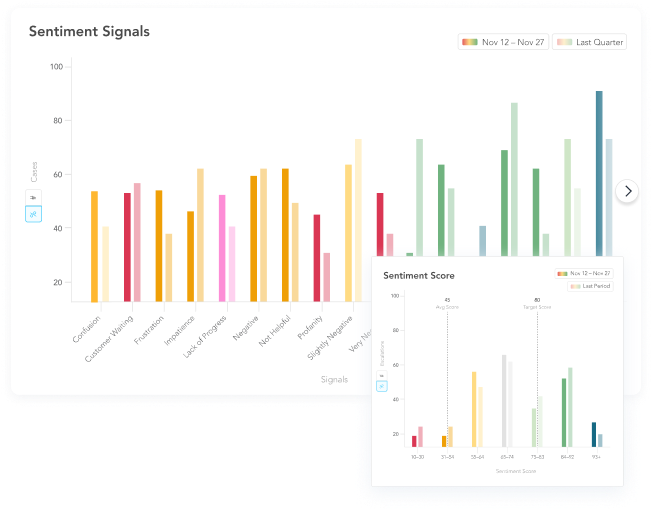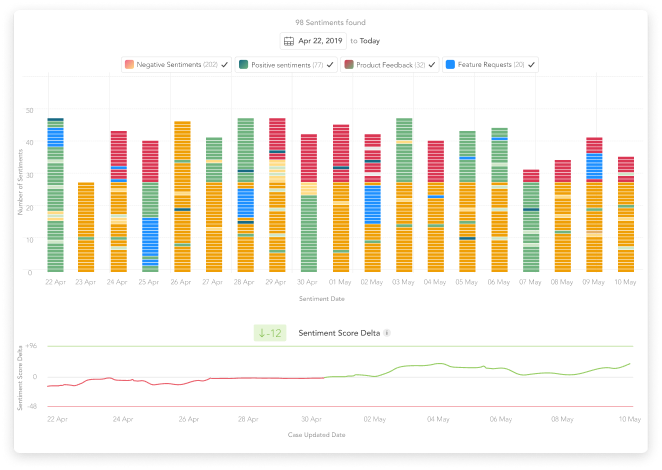
Aug 26, 2021
Contextual Intelligence: Not All AI is Created Equal
Artficial IntelligenceCX Transformation
Artificial intelligence (AI) is a growing area of customer service, with “56% of service decision-makers saying their organizations are actively looking for ways to use AI,” such as chatbots, text and voice analytics, and more.

However, AI on its own isn’t enough. It can’t fully mimic human interaction, which often leaves customers and customer service teams confused and distrusting of AI.
That’s where contextual intelligence comes in. Contextual intelligence enables AI systems to interpret information in the same way a person would, including adapting and applying what has already been learned. In the realm of customer support, this cutting-edge technology is key to transforming customer interactions from transactional to “context-aware.” This, in turn, produces more productive and successful results for both businesses and customers.
What is contextual intelligence AI?
Contextual intelligence takes a human-centered approach to AI. In short, it’s the next phase of AI that allows technology to understand context and surroundings and more clearly engage and interact with humans.
According to Oliver Brdiczka of Adobe, the four “pillars” of contextual intelligence in AI are:
- Intelligent. It can share how and why it came to the conclusions it did.
- Adaptive. It can work in different circumstances and conditions.
- Customizable. The user has total control over it.
- Context-aware. It can perceive and react in the same way a person might.
Brdiczka notes that self-driving cars are a good example “of a first attempt to understand more of the human context.” These cars use contextual intelligence to understand the roads, passengers, signs, and more to operate the vehicle as if a human controls a car. “However, the current understanding is still very limited and narrow.”
While we’re not quite there yet with true contextual AI, we are making significant strides forward.
How is contextual intelligence AI different from other forms of AI?
Most of us have heard stories or have firsthand accounts of AI being ineffective due to lack of context and human intelligence. Some that readily come to mind: unhelpful chatbot responses, out-of-the-box or irrelevant advertisements, or even those self-driving cars causing accidents.
These incidents lead to a lack of trust in the technology. But contextual intelligence provides the missing information necessary to make the technology reliable, efficient, and trustworthy. It gives support teams a plethora of data they can use to deepen their customer knowledge.
Contextual AI intelligence understands user interactions more clearly
Contextual intelligence helps machines better understand user intent and decision-making.
Previous AI technology fell short when situations and inputs differed, and it struggled to adapt to the changing environment. Contextual intelligence allows the technology to use multiple inputs and vantage points to recognize the specific emotions, environments, and other variables that your customers experience and analyze those interactions more clearly.
This increased understanding is essential in customer service and support because no two customers or interactions are the same. One-size-fits-all doesn’t work. By understanding the interaction more clearly through contextual intelligence, AI can deliver a more personalized experience and provide customers with relevant responses.
To see these benefits in action, consider a pharmaceutical company that partnered with Aktana to use contextual intelligence and AI for the release of a new oncology drug. The insights they collected helped the company craft targeted physician profiles and tailor messaging appropriately, which improved sales growth by 14%.
It can help minimize AI bias
While AI can help us understand customers, it also runs the risk of creating or exploiting biases.
According to Brdiczka, because “most AI approaches rely on large-scale data, unconscious bias can creep into AI algorithms based on the (positive and negative) examples with which they’ve been trained.” That data imbalance can lead to unintentional racist, sexist, and homophobic results. Examples of this include Amazon’s recruiting tool that favored male candidates and Microsoft’s chatbot Tay that quickly learned hate speech.
Increased intelligence and contextual awareness, which are key pillars of contextual intelligence, provide the context and human connection necessary to minimize biases. When we have a better understanding of how the algorithm draws conclusions, both the technology itself and human users/creators can detect and control unintentional bias as technology advances.
According to an analysis from the McKinsey Global Institute, “Unlike human decisions, decisions made by AI could in principle (and increasingly in practice) be opened up, examined, and interrogated. To quote Andrew McAfee of MIT, ‘If you want the bias out, get the algorithms in.’”
As AI gets smarter, thanks to contextual intelligence, it can more clearly make unbiased decisions. While we may not ever be able to fully eliminate bias due to human creators, true contextual intelligence can help us get closer to this goal.
How SupportLogic helps businesses leverage AI-powered contextual intelligence
SupportLogic, a continuous service experience (SX) platform, uses AI-powered contextual intelligence to help businesses provide better customer service. With our technology, support teams can gain a deeper understanding of their customers by tracking customer signals like sentiment, attention, intent, analyzing language and key phrases, and more.
Natural language processing enables richer understanding of customers signals
Natural language processing (NLP), a subfield of AI, allows the technology and customer service and support teams to better understand the context behind user interactions.
Using contextual intelligence, SupportLogic’s NLP can accurately determine the context, sentiment, and human emotions behind messages and important key phrases in support tickets and chats, which often get lost in translation or are lacking in many customer service scenarios.
SupportLogic’s NLP capabilities allow you to automatically extract 30 different signal categories and thousands of keywords to recognize what’s going on with your customers and monitor responses. This is crucial to truly offer full support and fill in the gaps left by traditional reactive customer satisfaction metrics like CSAT and NPS.

We help support teams track and analyze sentiment metrics
In addition to tracking the context and sentiment behind your customer interactions, SupportLogic uses contextual intelligence to organize and analyze this qualitative data, so it’s easy for your team to use.
Our SX platform collects sentiment from both customers and your agents, drills down to see specific sentiments and product feedback based on conversations, quickly scans keywords, and tracks escalations. It then uses this data to provide actionable recommendations and show you unexpected anomalies that you wouldn’t have noticed without AI (and contextual intelligence).
This easy-to-understand data and monitoring can alert you to customers who might churn and help you deliver a better, proactive customer service experience.

Contextual intelligence is the future of customer service
As AI technology continues to improve, many customer service teams are looking to integrate AI into their day-to-day work. If you’re looking to use AI, advanced tools like SupportLogic provide the contextual intelligence you need to improve the overall experience for your team and customers. Get started with a test drive today.
Don’t miss out
Want the latest B2B Support, AI and ML blogs delivered straight to your inbox?




